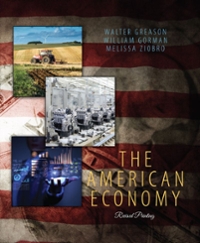Question
Consider a Ricardian Model of two countries (Chile and Mexico) and two goods (Textiles and Wine). The production technologies are specified by the unit labor
Consider a Ricardian Model of two countries (Chile and Mexico) and two goods (Textiles and Wine). The production technologies are specified by the unit labor requirements shown below: Chile Mexico (*) Textiles (T) 3 4 Wine (V) 1 4 Suppose there are 120 units of labor in each country, consumers have "nice" and identical preferences and both commodities are consumed in autarky. Since no specific utility functions/indifference curves are provided the consumption bundles would depend on the particular indifference curves you draw (the word "possible" refers to any such bundles) . Justify fully. Use a diagram or an equation when you are able to do so (when drawing PPF's use the horizontal axis for Textiles). Answer questions (1) to (8). (1) Graph the production possibilities frontier and a possible autarky point for both countries (put Textiles in the horizontal axis). (2) What are the autarky relative prices pT / pV in each country? Which country has a comparative advantage in Wine? (3) Draw a possible excess demand function for Wine in Chile. (4) Calculate the real wage in terms of Textiles and the real wage in terms of Wine for Chile in autarky. Suppose that when both countries Trade Freely, the relative price of Textiles in terms of wine is 2, (i.e. pT/pV = 2). (5) Draw a new graph for Mexico showing: the free trade production point, a possible consumption point, exports and imports. (6) Calculate the real wage in terms of Textiles and the real wage in terms of Wine for Mexico under Free Trade. (7) Assume that Textiles is used as a numeraire (i.e. pT = 1). Calculate the average cost of producing Textiles and Wine in Mexico under Free Trade. (8) (8 pts) Draw the World Relative Supply Curve (put pT/pV in the vertical axis, T + T* / V + V* in the horizontal axis and identify where the jump occurs). Draw a "nice" World Relative Demand curve that crosses the World Relative Supply curve at the stated free trade price ratio Suppose both countries have been trading for many years when Chileans discover a better way to produce wine. As a result, the marginal product of labor in the Chilean wine sector is now 1.5 (i.e. MPLV = 1.5). Everything else in the two countries stays the same. Suppose further that both countries are still trading freely and positive amounts. Answer questions (9) to (11). Justify fully. (9) Draw the new PPF for Chile. (10) What is the new autarky relative price pT / pV for Chile? Which country has a comparative advantage in Wine? (11) ) Draw the new World Relative Supply, the old one and the World Relative Demand to determine what will happen to the Free Trade equilibrium relative prices.
Step by Step Solution
There are 3 Steps involved in it
Step: 1

Get Instant Access to Expert-Tailored Solutions
See step-by-step solutions with expert insights and AI powered tools for academic success
Step: 2

Step: 3

Ace Your Homework with AI
Get the answers you need in no time with our AI-driven, step-by-step assistance
Get Started


